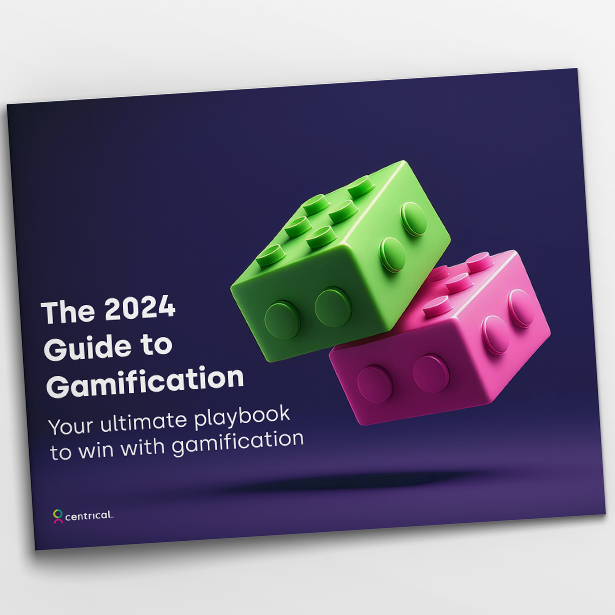Raffles at Work
A raffle, in which employees get “numbered” tickets with each representing a chance of winning a prize, is a great motivational tool to drive employee engagement: Raffles are a great way to focus everyone on a business goal, make them aware of a new product or process or engage in learning.
We’ve seen managers in sales organizations or contact centers use raffles to drive their agents to hit and exceed their targets. We’ve also implemented raffles in learning and HR contexts too.
How Raffles Work in a Gamified Environment
When raffles are used within a gamified workforce management or learning platform, the goal for employees is to collect as many raffle tickets as possible, to increase their chances of winning. This taps into collection as a motivator.
Though a raffle in nature relies on an extrinsic motivation (an interesting read about the difference between intrinsic and extrinsic motivation can be found here), correct design of the raffle challenge can also tap into intrinsic gamification motivations, such as mastery, autonomy and relatedness (see here).
In the Centrical platform, raffles are powered through the Centrical engagement automation capability, through its rule engine.
Let’s see how raffles actually work in the context of a gamified workforce management or microlearning engagement platform:
Centrical raffles are based on these five principles. The same ideas guide us in all platform deployments:
1) Provide immediate feedback – gamification platforms track real-time data about employee performance and learning and reflect this immediately to employees. This means that raffle tickets are immediately triggered and distributed when employees reach a certain goal. Technically, this occurs through an automated message that is sent when employees earn a raffle ticket. In addition, employees can see their ticket balance at any given point and the platform helps them easily understand what they need to do next to earn another raffle ticket, supported by nudges and call-to-action messages.
2) Covering different employee segments and a wide range of desired behaviors – To target many types of employees and behaviors, raffle tickets should be triggered by a variety of triggers. For example, employees can earn raffle tickets by hitting a certain percentage of their targets on one KPI or more and another ticket if they exceed their target. Employees can also earn extra ticket if their team hit the team target, or when they completed their weekly learning missions. Earning tickets by demonstrating several desired behaviors and reaching results in several metrics, makes the raffle much more engaging and relevant to a wider range of employees with different proficiency and competency levels (rather than just focusing on one metric, which might make the raffle relevant only to top performers). It strengthens the sense of the employee’s autonomy, since the employee can choose how they want to earn raffle tickets, selecting their own path to achieve them.
3) Scale and breadth of deployment – Getting the most out of your raffle contest also means including as many employees as possible in it. Think of a manually-administered raffle: even a contest with simple rules can be difficult to manage when applied to hundreds or thousands of employees, where each employee or team might have a different target. Platforms such as Centrical enable you to quickly set up a rich raffle contest and apply it to thousands of users spread out in different physical locations with almost no on-going administrative work.
4) Leveraging the power of social – participating (and winning) in a raffle as a team, where there is a team goal, can help drive individual performance. In some cases team contests drive more motivation than individual goals (this is a great example). Raffles on a team level can be great drivers of motivation.
5) Quick analysis – Gameffective’s analytics modules allows you to monitor in real-time the results during the raffle period and adjust the rules accordingly, if required. It also helps you analyze the results at the end of the raffles and get insights and meaningful conclusions for next steps.
So, do raffles really work?
Definitely yes! We’ve used raffles in campaigns with great results.
In a North American Call Center, focused on consumer debt collection, agents earned raffle tickets by (1) hitting their personal targets on 5 different KPIs, (2) winning the individual weekly competition (performance and learning) or (3) winning a weekly team competition. In this case, a raffle campaign resulted in increasing KPI results by 2.5 to 16 compared to agents that we’re engaged with the raffle.
In a Swedish Call Center, Agents earned tickets by (1) improving weekly “Ready Time” results, (2) performing well compared to others and (3) completing learning tasks. Agents that engaged with the raffles improved their “Ready Time” by 10% and maintained their results afterwards.
To summarize, a raffle is a powerful proven engagement mechanism. Running it on a gamified digital platform can help making the most out of it, increase performance and learning results even more and provide a clear ROI to the business.
Engage and motivate your frontline teams
Improve performance with an AI-powered digital coach
Deliver world class CX with dynamic, actionable quality evaluations
Boost performance with personalized, actionable goals
Nurture employee success with the power of AI
Listen and respond to your frontline, continuously
Drive productivity with performance-driven learning that sticks
Drive agent efficiency, deliver client results
Keep tech teams motivated and proficient on products and services while exceeding targets
Maintain compliance while building customer happiness and loyalty
Enlighten energy teams to boost engagement
Engage, develop, and retain your agents while driving better CX
Improve the employee experience for your reservations and service desk agents








 Dalit Sadeh
Dalit Sadeh April Crichlow
April Crichlow Ella Davidson
Ella Davidson Linat Mart
Linat Mart Gal Rimon
Gal Rimon Jayme Smithers
Jayme Smithers Doron Neumann
Doron Neumann Daphne Saragosti
Daphne Saragosti Ronen Botzer
Ronen Botzer Ariel Herman
Ariel Herman